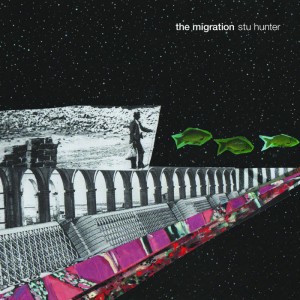The Migration by Stu Hunter, review by John McBeath, first published by the Australian
Sydney pianist/composer Stu Hunter produced a widely acclaimed, comprehensive work for quartet in 2007The Muse, followed by an equally expansive and highly regarded suite for sextet The Gathering, showcased to universal praise at the Wangaratta Festival of Jazz and Blues in 2010.
Now comes a worthy successor to those earlier pieces and in some ways a continuation of them: a 74 minute musical odyssey for octet, in nine parts entitled The Migration, due to be launched at the Sydney Festival on Saturday January 9th.
As with the earlier compositions this latest work achieves an almost symphonic form in its structure, using illustrative, sometimes orchestral-style formats, mood variations, and a thematic/melodic continuity all within a highly individualised jazz context.
The opener, Dawn Chorus begins with a soft clock-like beat, overlaid with a pacifying ensemble theme that sounds vaguely classical even after Cameron Undy’s electric bass riff and Simon Barker’s drums pick up the rhythm. Led by Phil Slaters’s trumpet the ensemble’s melody wanders against the insistent fast rhythm drums and bass, giving way to the deep muttering of Julien Wilson’s bass clarinet conclusion.
A variation of the opener’s infectious rhythm continues in track two Eagle Fish, with a strong piano pattern leading the ensemble as Matt Keegan’s baritone sax breaks into a raucous rollicking solo, followed by the piano’s ongoing building bounce and excited stabbing chords from the group’s voicings to conclude with a brilliant solo electric bass passage.
Three of these nine movements feature a solo vocalist: two by Tina Harrod and one from Katie Noonan. In each of these arrangements the voice is treated as a solo instrument and the poetically abstract lyrics – also by Hunter – are supplied in the cover notes. Twelve Stages of Freedom features an ethereal Noonan with her astonishing range, adding a high-treble duet with the clarinet of Julien Wilson, who also provides a solo.
One of Harrod’s two contributions, MDU Moonshine has a New Orleans soul element that fits well with her vocal style and features a blast-off trombone solo from James Greening, another on alto clarinet by Matt Keegan plus Carl Dewhurst’s wailing guitar, while Hunter’s piano punches a near-boogie ostinato along underneath throughout.
The closer Land of Gypsies, clearly influenced by the broad genre of European Gypsy music, makes good use of James Greening’s tuba establishing a Romany groove along with Hunter’s travelling piano, while Dewhurst’s lift-off guitar solo reaches into Pat Metheny territory against speeding piano and classical high-note flourishes from clarinet and tenor sax.
High praise is due to Hunter for this third edition of his extensive compositions and for his vigorous piano work on the recording, and also for the seven other top level musicians and two outstanding vocalists who’ve interpreted this monumental work.
















Absolutely refreshingly music of an era gone by, modernised through a keen awareness of the the past, present and of the new. What is amazing is the feeling Stu and band do deliver to weave a tapestry of cognition to all who hear the semblance of their collective musical story. WOW, who needs words? If not the album art is any hint to the philoshophy of what is is in their pshyce. We are in a craftily pasted Jungian landscape which is the collective un/conciousness setting the back/foreground of sensibilities. Awsomely un/worldy music.
PS Great comparitive symbolism of the openinig moodily unwordly watery electric bass rhythm adorned with the conventionally overlaid phrasing. As the tensions of everything is recognised.